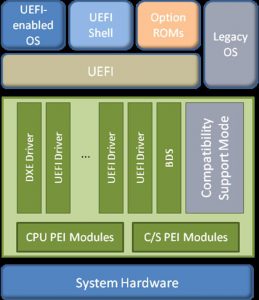UEFI (Unified Enhanced Firmware Interface) is a specification that defines a new interface and architecture for the system firmware that initializes server hardware subsystems before starting the OS boot process. It is now touted as a long-term successor to the BIOS system, which has been part of the x86 system architecture since its inception. Keep reading to understand more about its strengths and challenges.
Origins of UEFI
UEFI began as EFI, or the Enhanced Firmware Interface, and it was first proposed for the development of the Intel Itanium-based systems in the late 1990s. Because the Itanium architecture was essentially starting from scratch, there wasn?t much downside to defining a new firmware architecture for it. UEFI has grown out of a desire to extend this new firmware architecture to x86-based systems.
UEFI Architecture
UEFI also establishes its own pre-OS environment, including APIs and services that can be used to create applications for a variety of purposes, including configuration. This is known as the UEFI Shell.
UEFI was designed to bring modularity to system firmware by implementing a driver-based approach to platform initialization. Hardware and device chipsets will have a UEFI driver that allows the system firmware to initialize them through a standard API rather than having to program them directly. The UEFI architecture is shown in the figure below.

Implications of UEFI
While UEFI is causing a great deal of discussion in the industry, it?s important to note where we?re at regarding UEFI as well as the customer benefits and challenges of re-implementing system firmware to UEFI specifications.
Remembering the basic purpose of system firmware for the OS
Regardless of whether a server uses the BIOS or UEFI, the system firmware performs several basic functions in system start-up, such as initializing server hardware and starting the OS boot process. Once the OS is fully operational, it doesn?t rely much on the system firmware. So, whether the system was initialized using UEFI or the BIOS makes little difference to the OS performance or operational characteristics. Both the BIOS and UEFI provide the ability to create value-added functionality in the pre-boot environment and provide runtime features such as power management that occur below the OS
Re-writing the system firmware
UEFI requires the entire system firmware to be re-written, which is a significant task. Keep in mind that UEFI does not drive any particular new server features or provide any definitive customer benefits. In addition, the UEFI specification and development tools are evolving, making it beneficial to wait and continue to evaluate the maturity of the UEFI system. The BIOS-based firmware in HP ProLiant servers has more than 20 years of evolution and testing behind it, making it a very stable platform. HP BIOS-based system firmware also provides important HP-specific functionality, including platform and power management. Producing and testing an entirely new system firmware based on a new architecture demands a slow and deliberate approach.
HP ProLiant servers and UEFI.
At HP, we are always evaluating new server technologies, including UEFI. Currently, we believe that the best customer value for ProLiant servers is provided by continuing to use BIOS-based firmware. Going forward we will continue to evaluate and remain involved in the UEFI efforts so that we can determine when and where it may add customer value and provide development flexibility.
Additional resources

